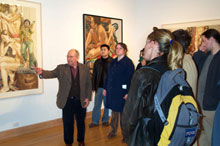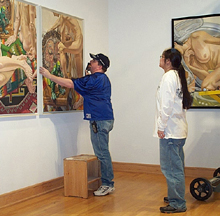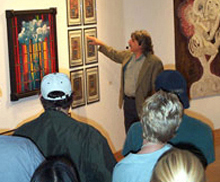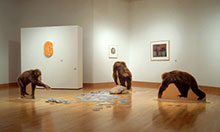The visual arts provide us with a powerful and exciting language for communicating ideas and sharing emotions. Visual expression relies on a creative process that embraces insight and discovery, an experience first encountered by the artist and then by the viewer. The purpose of an exhibition space is to create an open forum where art can be encountered and considered on an experiential level. This cycle of visual experience directly affects our perceptions and serves to enrich our lives, expand our awareness, and promote understanding. From this perspective, art is a valuable and fundamental component of our culture and the existence of creativity in our communities makes us stronger as a society.
As a curator, artist, and educator I have had extraordinary opportunities to take part in the process of experiencing art. My curatorial philosophies are significantly influenced by my work as an artist and deeply informed by my role as an educator. I sincerely believe in the power of art to inform, inspire, entertain, transform, persuade and beautify and my drive as a curator is greatly influenced by my passion for the arts.
Art is most often displayed in galleries and museums, environments often removed from the experiences of everyday life. The challenge for the contemporary curator is to make a connection between the exhibition space, the work displayed there and the communities that are being served. The exhibition of art invites an opportunity for a meaningful exchange between artist and viewer and provides an occasion for the integration of experiences from the outside world with those of the inner self. With this in mind, curatorial goals should focus on the integrity of the work displayed and the method with which it is displayed, and the continued development of an audience. Within the exhibition space, the curator should be invisible allowing the art to be the primary visual focus. However, outside of the gallery it is important for the curator to be highly visible and instill enthusiasm, encourage curiosity and affirm the experiential qualities of the arts within the community.
In education, art becomes important because it teaches response, helps to build performance and promotes an understanding of creativity. Colleges and universities play an important role in the legitimization and authentication of culture and the role of a university exhibition space is to provide a vehicle for interpretation and education. To students, faculty and staff, the gallery should act as an integral part of personal and professional development. To the more general audience, the gallery should offer fresh challenges and act as a catalyst to addressing new aesthetic and intellectual issues.
The implementation of a successful curatorial program requires the provision of a positive environment for the display of art. This is done through the application of professional practices to all phases of the program from selection of exhibitions to daily operations to special events and outreach to proper training of personnel. The establishment and function of support committees is essential in order to achieve program integrity, diversity, varied community input and the establishment and acquisition of strategic goals. In the end, it is important to maintain an environment that allows for open dialogue, creative innovation, and artistic research. A successful program is ultimately distinguished by quality exhibitions, lectures and events, and active participation.



